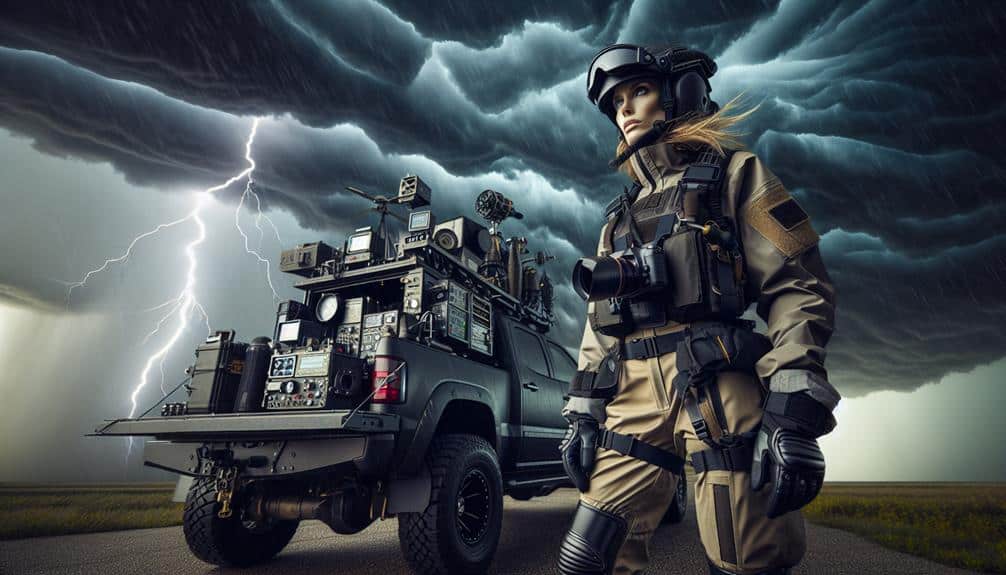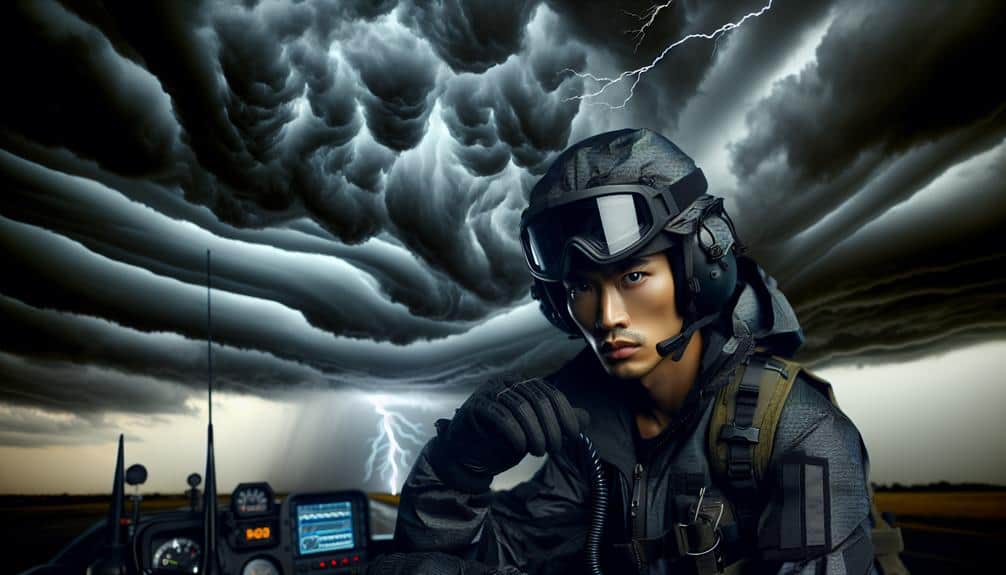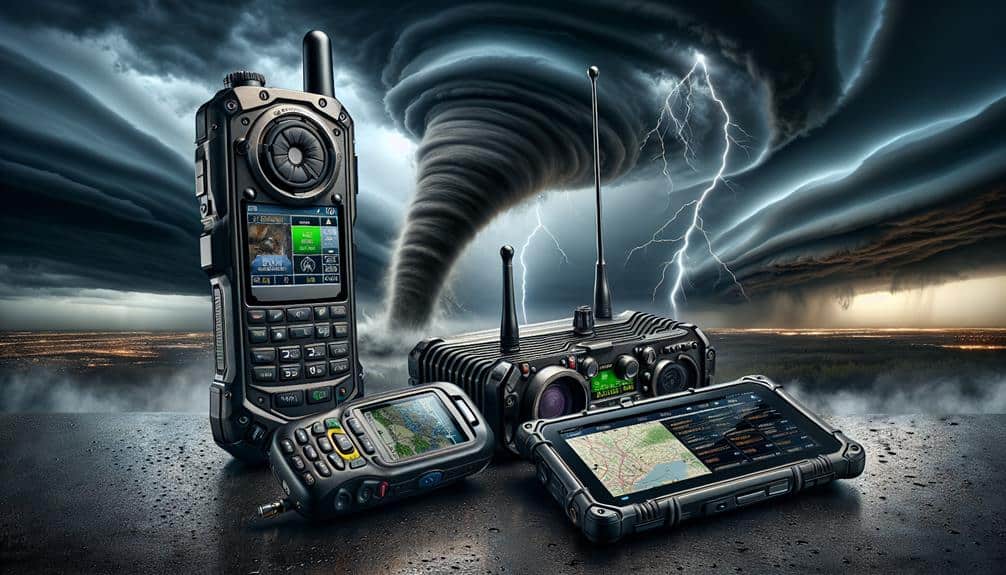As dedicated storm chasers, our top 10 necessary items guarantee we stay safe and effective in the field. A weather radio and GPS device keep us informed and on track. First aid kits are essential for treating injuries, while durable footwear and waterproof clothing maintain our mobility and comfort. Emergency food supplies and portable power banks provide sustenance and keep our devices running. Ensuring our sturdy vehicle is equipped with communication tools and weather monitoring systems is vital. Lastly, durable camera gear captures stunning visuals, and safety helmets protect us from high-impact dangers. For more insights on essential storm-chasing gear, keep going.
Key Points
- Weather Radio: Real-time NOAA updates and alerts for weather conditions.
- High-Quality GPS Device: Accurate location data and navigation assistance.
- First Aid Kit: Essential for addressing injuries and medical emergencies.
- Durable Camera Gear: Designed to withstand extreme weather conditions.
Weather Radio
For storm chasers, a reliable weather radio is indispensable for receiving real-time updates and alerts. As we chase storms, having immediate access to weather information can mean the difference between safety and danger. Weather radios receive broadcasts from NOAA (National Oceanic and Atmospheric Administration) and provide vital emergency alerts about severe weather conditions, such as tornadoes, thunderstorms, and flash floods.
To maximize our efficiency and safety, our weather radios should feature Specific Area Message Encoding (SAME) technology. This allows us to program the radio to receive alerts for specific geographic areas, reducing unnecessary noise and ensuring we get the information pertinent to our location.
A good weather radio will also have multiple power sources, including batteries and hand-crank options, ensuring we remain connected even when the power grid fails.
Integrating our weather radio with a GPS device enhances our navigation assistance capabilities. By comparing the weather data with our current location, we can make informed decisions about where to go next and which areas to avoid. This combination of real-time weather updates and precise location tracking empowers us to pursue our passion while maintaining our freedom and safety.
GPS Device
A high-quality GPS device is important for storm chasers to navigate safely and efficiently during severe weather conditions. When we're out chasing storms, GPS accuracy becomes vital. We need to know our exact location at all times to make real-time decisions based on rapidly changing weather patterns. A device with high GPS precision helps us avoid dangerous areas and stay on the best course to intercept storms.
Battery life is another essential factor to keep in mind. We can't afford to have our GPS device die in the middle of a chase. Look for devices that offer extended battery life or have options for portable charging. This ensures we remain operational even during long hours in the field.
Signal strength is equally significant. We often find ourselves in remote areas where cellular service is weak or nonexistent. A GPS device with strong signal strength ensures we stay connected and receive accurate location data regardless of our surroundings.
Additionally, take into account data usage when selecting a device. Some GPS units require extensive data, which can be challenging in areas with limited connectivity.
First Aid Kit
Carrying a complete first aid kit is crucial for addressing potential injuries and medical emergencies while storm chasing. The unpredictable nature of storms, combined with the rugged terrain often encountered, makes wilderness survival a critical concern. A well-stocked first aid kit can be the difference between a minor inconvenience and a life-threatening situation.
To make sure we're prepared, our first aid kit should include:
- Basic Medical Supplies: Bandages, antiseptic wipes, adhesive tape, and sterile gauze pads to manage cuts, scrapes, and minor wounds.
- Emergency Medications: Pain relievers, antihistamines, and any personal medications to address immediate medical needs.
- Specialized Tools: Tweezers, scissors, and a digital thermometer for precise medical intervention.
Having these items on hand allows us to address common injuries promptly and effectively.
In the event of a severe injury, such as a broken bone or a deep laceration, the first aid kit becomes our immediate line of defense until professional medical help arrives. It's not just about patching up wounds; it's about maintaining our freedom to explore and chase storms safely.
Proper preparation highlights the importance of a first aid kit in any storm chaser's arsenal.
Durable Footwear
When storm chasing, we must prioritize sturdy footwear to guarantee safety and mobility across diverse and often risky terrains. Our shoe selection should focus on weather protection and the ability to withstand extreme conditions. Given the unpredictable nature of storm chasing, we need shoes that can handle everything from muddy fields to rocky landscapes without compromising on endurance.
Footwear durability is crucial. We should look for shoes made from high-quality materials such as Gore-Tex or other strong synthetics. These materials not only provide excellent weather protection but also ensure the shoes can endure repeated exposure to harsh elements. Reinforced toes and sturdy soles are essential to protect our feet from debris and uneven ground.
Comfort features shouldn't be overlooked either. Storm chasing often involves long hours on our feet, so shoes with good arch support, cushioned insoles, and breathable linings are significant. Proper fit is also essential to prevent blisters and ensure maximum comfort during extended treks.
Ultimately, our footwear choice can have a notable impact on our storm chasing experience. By selecting shoes that offer both durability and comfort, we can navigate any terrain confidently and focus on the thrill of the chase.
Waterproof Clothing
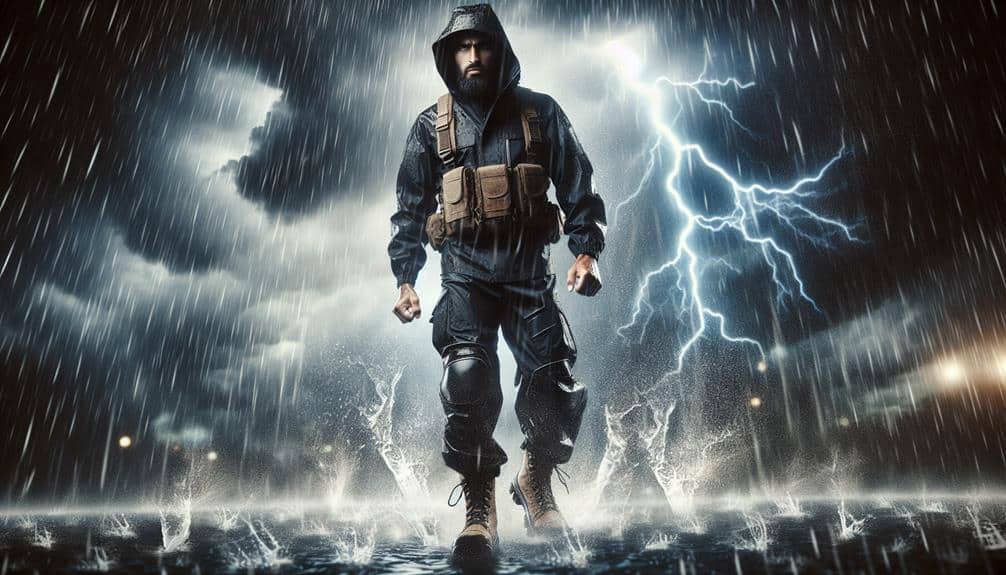
Besides durable footwear, we must equip ourselves with waterproof clothing to stay dry and maintain body heat during intense weather conditions. Storm chasing demands a strategic approach to dressing, making sure we're prepared for anything nature throws our way. The right waterproof clothing is vital, and it's all about the layering strategy and material quality.
- Layering Strategy: By using a layering strategy, we can regulate our body temperature effectively. Start with a moisture-wicking base layer to keep sweat off your skin. Follow it with an insulating mid-layer such as fleece or wool to trap heat. Finally, add a high-grade waterproof outer layer to block rain and wind.
- Material Quality: The quality of the materials we choose can make or break our storm-chasing experience. Look for fabrics like Gore-Tex or eVent, known for their exceptional moisture resistance and breathability. They'll keep us comfortable and dry without overheating.
- Staying Dry: Staying dry isn't just about comfort; it's vital for our safety. Wet clothing can rapidly lead to hypothermia, especially in windy conditions. Investing in high-quality waterproof gear ensures we remain dry, warm, and focused on the storm.
High-Quality Camera
A high-quality camera is essential for us to capture extreme weather phenomena with precision.
It's important that our equipment can withstand harsh conditions, ensuring durability and reliability.
Capturing Extreme Weather Phenomena
Investing in a high-quality camera is vital for storm chasers aiming to capture detailed and dramatic images of extreme weather phenomena. As storm chasers, it's imperative that mastering storm chasing techniques and adhering to safety precautions are paramount. A high-quality camera allows us to document extreme weather photography and capture the perfect shot safely and efficiently.
When selecting a camera, we should consider the following features:
- High Resolution: A camera with a high megapixel count ensures that our images are sharp and detailed, even when zoomed in or cropped.
- Fast Shutter Speed: To freeze the action of lightning strikes or swirling tornadoes, a fast shutter speed is essential.
- Low-Light Performance: Extreme weather often occurs under low-light conditions, so a camera with excellent low-light capabilities is a must.
Using these features, we can capture the majesty and power of storms while safeguarding our safety. By integrating these tools with our storm chasing techniques, we're better equipped to capture awe-inspiring moments.
Durability in Harsh Conditions
Our high-quality camera must withstand the harsh conditions encountered during storm chasing to guarantee reliable performance and longevity. When faced with extreme weather, the durability of our equipment becomes essential.
Cameras designed for these conditions often feature rugged exteriors, reinforced seals, and weather-resistant materials, ensuring they can operate effectively despite heavy rain, strong winds, and sudden temperature changes.
Durability in our camera gear isn't just about surviving the elements; it's also about maintaining functionality when we need it most. Cameras with robust construction typically have shockproof designs to protect against accidental drops or impacts. Additionally, water and dust resistance ratings (IP ratings) are vital to keep the internal components safe from moisture and debris, which are common in storm environments.
To align with our survival gear, a high-quality camera must integrate seamlessly into our overall preparedness strategy. It should be lightweight enough to carry with ease but hardy enough to endure prolonged exposure to adverse conditions.
Features like long battery life and quick charge capabilities are essential, allowing us to capture critical moments without interruption. In sum, a durable, high-quality camera is indispensable for any storm chaser committed to documenting extreme weather safely and effectively.
Emergency Food Supply
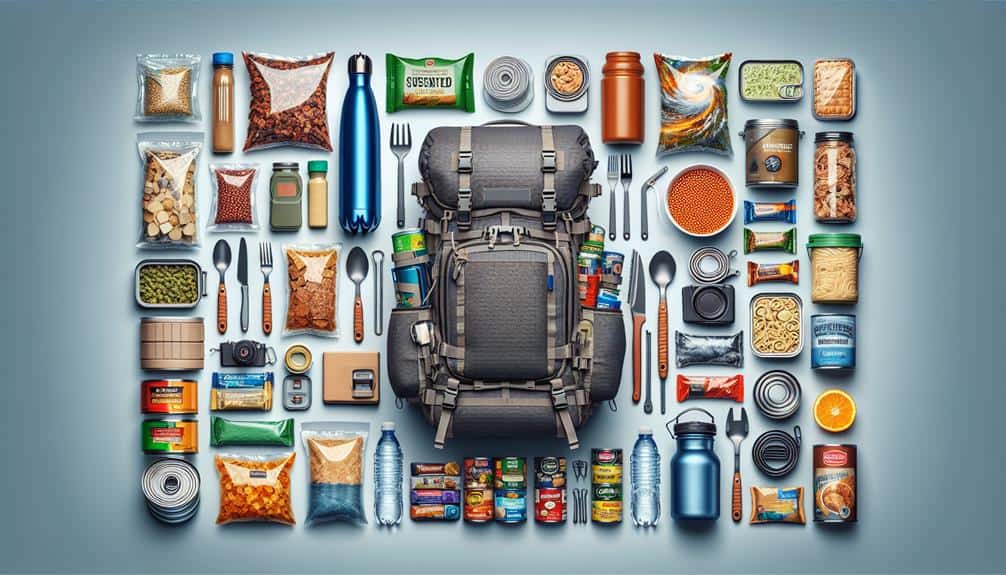
Stocking an emergency food supply guarantees we stay energized and focused during the unpredictable conditions of storm chasing. Proper storm preparation involves not only securing an emergency shelter but also ensuring we've sustenance that can withstand the elements.
Our food supply should be carefully chosen for long term storage, fitting seamlessly into our overall survival planning strategy.
To keep our energy levels high and our minds sharp, we recommend the following three essential items:
- High-Calorie Energy Bars: These are compact, easy to store, and provide a quick energy boost. They're designed for long term storage, making them perfect for extended trips.
- Dehydrated Meals: Lightweight and requiring minimal preparation, dehydrated meals are excellent for survival planning. Just add water, and we've a nutritious meal ready to go.
- Canned Goods: While slightly heavier, canned goods offer durability and a long shelf life. They don't require refrigeration and can be eaten cold if necessary, providing a reliable food source.
Portable Power Bank
Let's discuss the pivotal role of a portable power bank in our storm chasing toolkit.
It provides essential charging capability for our devices, ensuring we stay connected in remote areas.
Additionally, its lightweight and durable design means it won't add unnecessary burden while withstanding harsh conditions.
Essential Charging Capability
Given the unpredictable nature of storm chasing, having a reliable portable power bank guarantees our electronic devices stay charged and functional. It's essential when we're in remote locations, far from conventional power sources. A portable power bank secures that our GPS, communication devices, and weather tracking equipment remain operational.
To maximize our charging capability, we should consider the following features:
- Solar Panel Integration: A power bank with a built-in solar panel allows us to harness renewable energy, providing an infinite power source even when we're off the grid for extended periods. This feature is particularly beneficial during long chases under daylight conditions.
- High Capacity: Opt for a power bank with a large mAh (milliampere-hour) rating. This secures we've ample power to recharge multiple devices multiple times, reducing the need for frequent recharges from a fixed power source.
- Backup Generator Compatibility: In extreme scenarios, we need our power bank to be compatible with a backup generator. This capability secures we've a reliable way to recharge the power bank itself, regardless of weather conditions or time of day.
Implementing these features secures that we maintain our freedom and flexibility while storm chasing, securing our equipment remains ready for action.
Lightweight and Durable
While guaranteeing robust charging capabilities, we must also prioritize a portable power bank's lightweight and sturdy design to withstand the harsh conditions of storm chasing. A power bank that meets these criteria will enhance our mobility and resilience during unpredictable weather events.
The device should be compact and reliable, fitting seamlessly into our gear without adding unnecessary weight. Its durability is vital, as it will be exposed to rough handling and potentially extreme conditions.
In scenarios where we might need to quickly set up an emergency shelter, having a lightweight power bank ensures we're not burdened by heavy equipment. This agility is crucial for maintaining our freedom and safety.
Additionally, the power bank should be able to handle wet conditions, much like our quick dry gear, which is vital for keeping us operational in the field.
Technical specifications should include a high milliampere-hour (mAh) rating for extended use, multiple charging ports for versatility, and a rugged exterior to protect against shocks and moisture.
Sturdy Vehicle
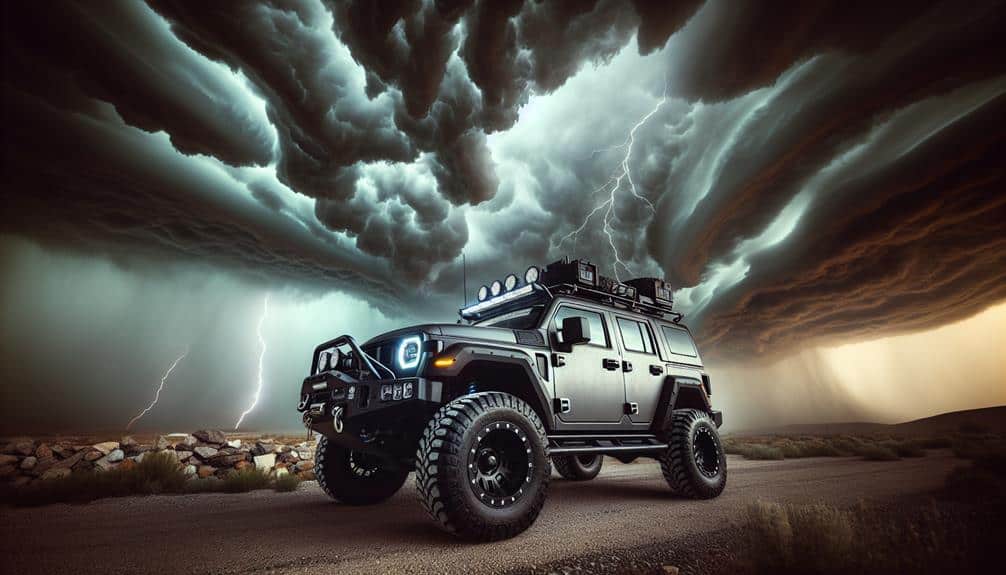
A sturdy vehicle is essential for storm chasers to navigate harsh weather conditions safely and effectively. We need a reliable mode of transportation to capture those perfect storm photography shots while ensuring our security.
Proper vehicle maintenance is vital, as it guarantees our vehicle can withstand the rigorous demands of storm chasing. Regular checks on tires, brakes, and engine performance can mean the difference between a successful chase and a risky situation.
To be fully prepared, we should focus on three key aspects:
- Durability: Our vehicle must be able to handle rough terrains and severe weather. Opt for one with reinforced frames and high ground clearance.
- Emergency Communication: Equipping our vehicle with reliable communication tools, such as a CB radio or satellite phone, enables us to stay connected during power outages and network failures.
- Storm Monitoring: Integrating advanced weather monitoring systems like Doppler radar and GPS tracking helps us stay ahead of the storm, making informed decisions about our chase routes.
Choosing the right vehicle and keeping it in top shape allows us to explore the freedom and thrill of storm chasing while prioritizing our safety and effectiveness.
Safety Helmet
Wearing a safety helmet is vital for protecting our heads from flying debris and other hazards during storm chasing. Our helmets need to meet stringent safety standards that ensure high impact resistance. This is essential because the conditions we face—high winds, hail, and falling objects—pose significant risks to our safety.
When selecting a helmet, we should consider its adherence to established helmet safety standards, such as those set by the American National Standards Institute (ANSI) or the Occupational Safety and Health Administration (OSHA). These standards guarantee that our helmets can withstand severe impacts, providing us with the best possible protection.
Customization options and helmet accessories can enhance our storm-chasing experience. For example, we can add face shields to guard against wind and rain, or attach communication devices to stay connected with our team. Ventilation systems can also be integrated to keep us comfortable during long hours in the field.
Frequently Asked Questions
How Should I Prepare My Vehicle for Extreme Weather Conditions?
Let's guarantee our vehicle maintenance is up-to-date, pack an emergency kit, organize equipment storage efficiently, and establish a solid communication plan. These steps will maximize our safety and freedom during extreme weather conditions.
What Are the Best Practices for Staying Safe While Chasing Storms?
When chasing storms, we must dance with the devil but prioritize safety precautions. Conduct thorough risk assessments, maintain robust communication strategies, and have an emergency response plan. By doing so, we guarantee our adventures remain thrilling yet safe.
How Can I Find Reliable Weather Updates While on the Move?
To find reliable weather updates while on the move, we can utilize live stream services and follow meteorologists on social media. These tools provide real-time data and alerts, helping us make informed decisions during our storm-chasing adventures.
What Should I Do if I Get Caught in a Severe Storm?
When the storm's fury hits like a freight train, we've got to act fast. First, secure emergency supplies. Then, follow our evacuation plan, seek shelter options, and maintain communication strategies to guarantee our safety and freedom.
Are There Any Specific Apps Recommended for Storm Chasers?
We recommend using storm tracking apps like RadarScope for their accuracy. For emergency communication and alerts, apps like Zello and NOAA Weather Radar are essential. These tools guarantee we're always informed and prepared during our chases.
